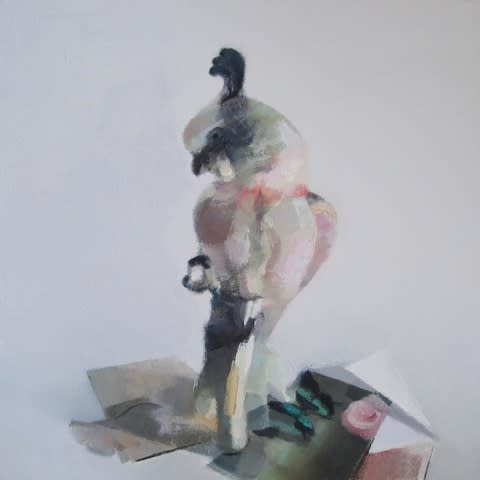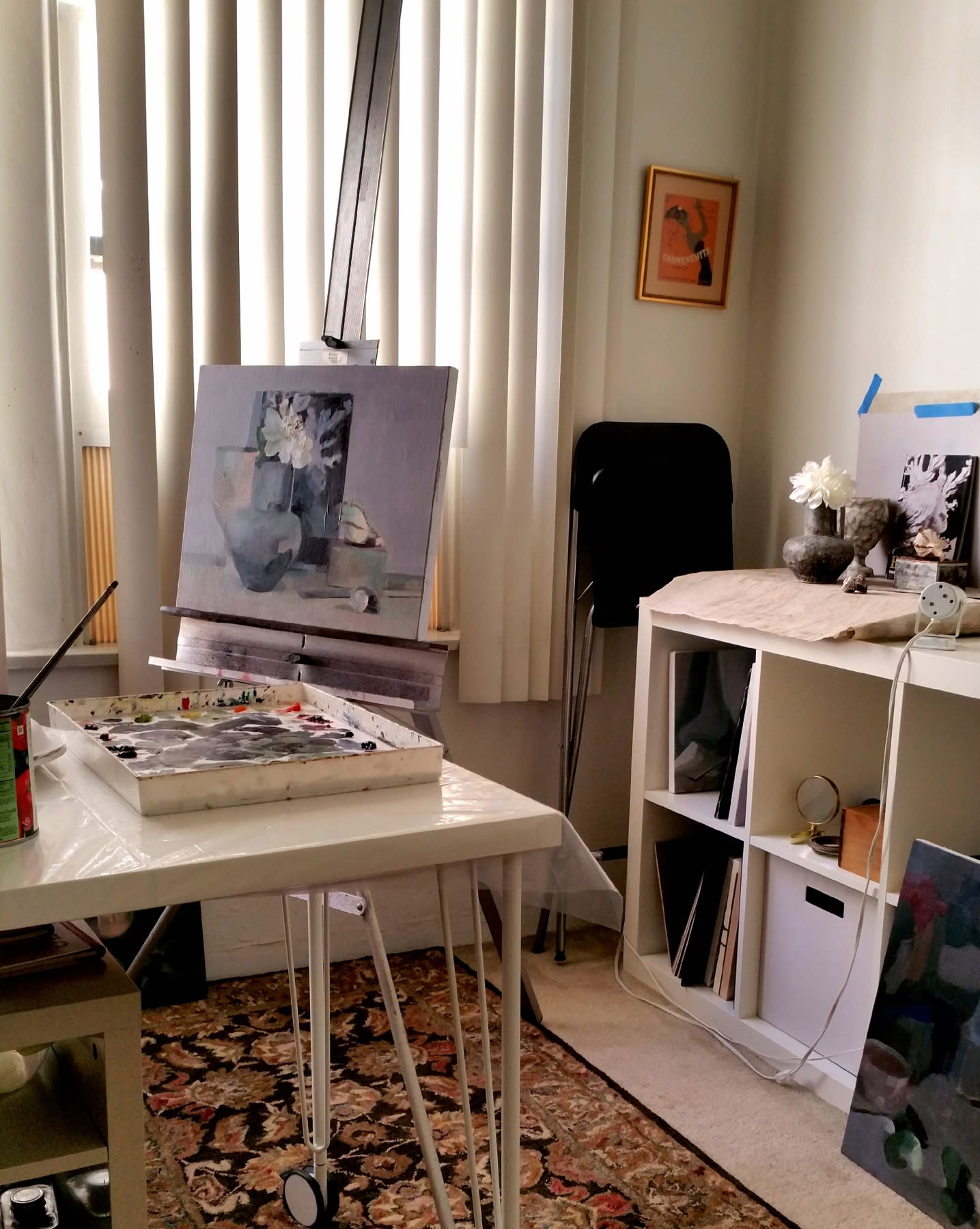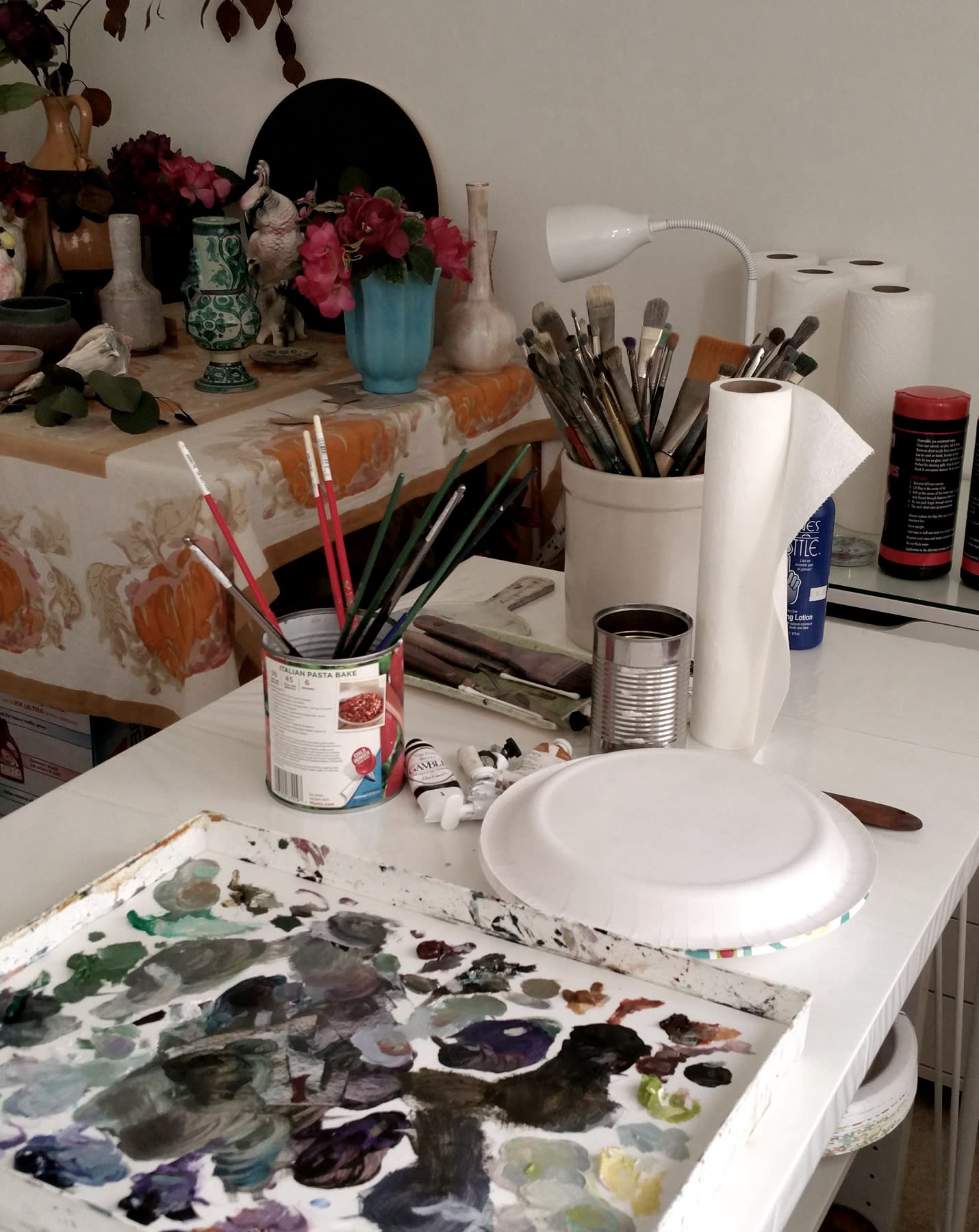
Every week, we'll be sitting down with one of our gallery artists to discuss their work, process, inspiration, and stories. This week we're speaking with Stephanie London.
Stephanie's London's paintings provide a quiet moment of beauty, a respite from from the bustle of our lives. Her thrifted objects in her still lives, like actors on a stage, command the attention with a mysterious sense of drama. Ultimately, her work reflects her Buddhist practice, exploring the same stillness and quieting of the mind that one finds in a state of prayer or meditation. London talked with us from California about the underlying narrative of her still life arrangements, finding fulfilment as an artist within an academic atmosphere, and the conflct of choosing between abstract and representational work.

Photo Courtesy of the Artist
What are some of your earliest memories relating to art?
Some of my fondest memories from my childhood are of going to the museum with my mother. The whole experience was exciting and intoxicating. The architecture (we all know that museums are examples of the latest trends in architecture), the art on the walls - sometimes challenging and thought provoking, sometimes just simply beautiful, the people fashionably dressed, the bookstore and the cafe. I've always been a very sensitive person. Because of my introspective and introverted nature, I never quite felt I belonged as a child. However, when I would go to a museum, I felt connected and like I had a tribe of people I could relate to.
Because my mother is so passionate about art, her enthusiasm rubbed off on me. She wanted to be an artist herself, and although she didn't pursue it very seriously while I was young, later she would go on to become a very accomplished plein air painter. I can still remember the smells of oil paint and turpentine in the kitchen on the occasions she did paint while I was young.
I was encouraged to draw and make things from an early age. As an only child, I was accustomed to occupying and entertaining myself, so reading and drawing became favorite pastimes. At age 14, after regular school, I started taking art lessons at a neighborhood studio, which I paid for myself. This is when I began seriously dreaming of being an artist. Yes, I liked to draw, but I think I was most attracted to the romantic bohemian image of the artist as both an outsider and independent thinker.

Photo courtesy of the artist
Your work used to be primarily abstract. What provoked your evolution from working in abstraction to focusing on still life and landscape?
I didn't start painting until my early thirties. Up until that time I worked in charcoal and pastel, focusing on developing a solid foundation in drawing. After a few years of art school, I was encouraged to leave what was criticized as an outdated, academic approach to art making and take a more abstract and expressive approach. This was the prevalent attitude on the West Coast in the 80s and 90s. Learning the technicalities of how to paint and learning how to see and work representationally or perceptually wasn't encouraged or emphasized as much as learning how to think and explore ideas. Although I was still working with recognizable images, I became less interested in representation and more interested in the symbolic expression of feelings and ideas, drawing inspiration from such artists as Robert Motherwell, Robert Mangold, Susan Rothenburg and Donald Sulton.
I pursued a form of contemporary abstraction for several years after graduating with my MFA and although there was interest in this work - I showed and sold a lot of paintings - I wasn't fulfilled as an artist. The work was very physically demanding, and not very much fun to make. Coming up with ideas for paintings was difficult and I became depressed. I stopped making art for two years and when I began again, it was strictly for myself and not for an audience or to be a part of an art scene. I went back to my representational roots and started to make very simple and personal still life paintings. It felt natural and made me happy.

A work in progress. Photo courtesy of the artist
What is your process like for creating your still lives? What decisions go into creating your arrangements?
The first step in developing a still life painting, is the set-up. This is the most creative and fun part and can sometimes take an entire day. The objects I use in my paintings are selected for a variety of reasons. I choose them for their personality, such as a porcelain bird with an attitude or a fish vase, but also I choose objects for their shape, color or texture.
The decisions that go into the initial set-up are very subjective and difficult to describe. It isn't an intellectual process. I arrange things according to how I'm feeling and I most likely project whatever is going on in my life onto my set-up. Maybe this is why the paintings have an undercurrent of a narrative.
Right now I'm in a transition with my still life work. The paintings are getting more complicated, perhaps less decorative and a little darker, as I'm learning to juggle more elements and explore more challenging compositions. Whereas in the past, a narrative might have been suggested by the object itself or in relationship with another, currently I'm more interested in the color and value transitions between objects.
I'm sort of a restless artist, never content with staying put in one place too long. I always want to try new things, expand my repertoire.
Could you elaborate on something you mention in your statement, the "certain quality of paint that [you] chase in pursuit of capturing an ever elusive feeling"? What is the quality you're searching for, and the feeling?
I've always admired painters whose handling of paint in and of itself is quietly expressive and satisfying without a lot of bravura. For example, Morandi. It's not just what he paints, but that elusive quality that comes through his hand. I want that in my work. Unfortunately, it isn't something you can force. However, I do have control as to what paint stays and what gets scraped off. Every inch of a painting's surface needs to feel right for me, which can be very frustrating at times. I put the paint on, I take the paint off. I want the painting to hold up from a distance and from up close. Because of this obsessive quest for a certain quality of paint, I've become a very slow painter, a little too perfectionist for my own good.
Recently I asked the painter Israel Hershberg about knowing when a painting is finished and he said "A painting is never finished, it's only abandoned." I immediately understood this since at some point I just give up and say, "Oh well, that's the best I can do," and it's time to move on.
Also in your statement, you say that the primary drive for painting is finding stillness, and giving that stillness for others. How did you come to find painting as a source for that stillness? How does it intersect, if at all, with your Buddhist practice?
Painting is therapeutic for me, similar to my Buddhist practice of chanting, It gives me a chance to stop the incessant negative chatter in my head and be in the moment. Still life painting demands incredible amounts of focus and perceptual observation. This type of intense concentration transports you to another zone, just like meditation does. Art at its best can transport you to another place or it can connect you to something deeply felt. If I can provide that kind of moment to another person through a painting, then I would say, job well done.
Explore more of Stephanie London's work here.
Comments
I loved this interview. A very natural and honest expression of an artist's thoughts and feelings. The whole part about being discouraged from representation and the pressure to conform in art school was so interesting. I'm glad the artist returned to painting her own beautiful visions.
Great article Steph! :D
There is so much behind those paintings that makes her work a cut above the rest!!